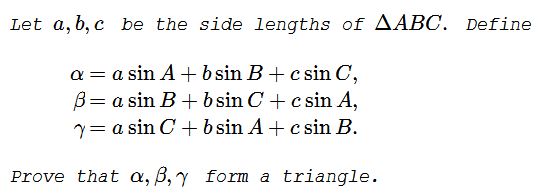One Triangle from Another
Problem

Proof 1
By the Law of Sines,
$\begin{align} u&=2R\alpha = a^2+b^2+c^2,\\ v&=2R\beta = ab+bc+ca,\\ w&=2R\gamma = ac+ba+cb. \end{align}$
Since obviously $u+v\gt w\;$ and $u+w\gt v,\;$ suffice it to show that $v+w\gt u,\;$ i.e.,
$2(ab+bc+ca)-(a^2+b^2+c^2)\gt 0.$
But the latter is equivalent to
$(\sqrt{a}+\sqrt{b}+\sqrt{c})(-\sqrt{a}+\sqrt{b}+\sqrt{c})(\sqrt{a}-\sqrt{b}+\sqrt{c})(\sqrt{a}+\sqrt{b}-\sqrt{c})\gt 0,$
which is true because, since $a,b,c\;$ form a triangle, so do $\sqrt{a},\sqrt{b},\sqrt{c}.\;$
Proof 2
From the Law of Sines,
$\displaystyle \alpha=a\sin A+\frac{b^2}{a}\sin A+\frac{c^2}{a}\sin A,$
i.e.,
$\displaystyle \frac{\alpha}{\sin A}=\frac{a^2+b^2+c^2}{a}.$
Similarly, $\displaystyle\frac{\beta}{\sin B}=\frac{a^2+b^2+c^2}{b}$ and $\displaystyle\frac{\gamma}{\sin C}=\frac{a^2+b^2+c^2}{c}.\;$ Written differently,
$\displaystyle a^2+b^2+c^2=\frac{a\alpha}{\sin A}=\frac{b\beta}{\sin B}=\frac{c\gamma}{\sin C},$
implying $\alpha=\beta=\gamma,\;$ as the sides of an equilateral triangle.
Proof 3
Lemma (a "triangularity" property)
Let $m,n,p\ge 0\;$ (not all zero). If $a,\;$ $b,\;$ $c\;$ are the side lengths of a triangle, then
$\begin{align} \alpha &= ma+nb+pc,\\ \beta &= na+pb+mc,\\ \gamma &= pa+mb+nc \end{align}$
are aslo the side lengths of a triangle.
Proof of Lemma
We prove that $\alpha+\beta\gt\gamma,\;$ i.e.,
$(ma+nb+pc)+(na+pb+mc)\gt pa+mb+nc.
This is equivalent to
$m(a-b+c)+n(a+b-c)+p(-a+b+c) \gt 0,$
for $a,b,c\;$ from a triangle.
The statement follows with $m=\sin A\gt 0,\;$ $n=\sin B\gt 0,\;$ $p=\sin C\gt 0.$
Proof 4
$\displaystyle\begin{align} \sin A +\sin B -\sin C &= 2\sin\frac{A+B}{2}\cos\frac{A-B}{2}-2\sin\frac{C}{2}\cos\frac{C}{2}\\ &=2\cos\frac{C}{2}\cos\frac{A-B}{2}-2\sin\frac{C}{2}\cos\frac{C}{2}\\ &=2\cos\frac{C}{2}\left[\cos\frac{A-B}{2}-2\sin\frac{C}{2}\right]\\ &=2\cos\frac{C}{2}\left[\cos\frac{A-B}{2}-2\sin\left(\frac{\pi}{2}-\frac{A+B}{2}\right)\right]\\ &=2\cos\frac{C}{2}\left[\cos\frac{A-B}{2}-\cos\frac{A+B}{2}\right]\\ &=4\sin\frac{A}{2}\sin\frac{B}{2}\cos\frac{C}{2}. \end{align}$
Now,
$\displaystyle\begin{align} \alpha+\beta-\gamma&=a(\sin A +\sin B -\sin C)\\ &\;\;+b(\sin B +\sin C -\sin A)\\ &\;\;+c(\sin C +\sin A -\sin B)\\ &=4a\sin\frac{A}{2}\sin\frac{B}{2}\cos\frac{C}{2}\\ &\;\;+4b\sin\frac{B}{2}\sin\frac{C}{2}\cos\frac{A}{2}\\ &\;\;+4c\sin\frac{C}{2}\sin\frac{A}{2}\cos\frac{B}{2}\\ &\gt 0. \end{align}$
Hence, $\alpha+\beta\gt\gamma.\;$ Similarly, $\alpha+\gamma\gt\beta\;$ and $\beta+\gamma\gt\alpha,\;$ implying that $\alpha,\;$ $\beta,\;$ $\gamma\;$ are the sides of a triangle.
Proof 5
Use the Rearrangement Inequality for sequences $\{a,b,c\}\;$ and $\{\sin A,\sin B, \sin C\}.\;$ By Euclid I.18, I.19, the two have similar orderings. Thus assuming, WLOG, $a\ge b\ge c,\;$ we also have $\sin A\ge\sin B\ge\sin C.\;$ It follows that $\alpha\gt\beta\;$ and $\alpha\gt\gamma.\;$ Remains it to show that $\beta+\gamma-\alpha\gt 0.$ To this end observe that, by the Law of Sines, $\displaystyle\sin A=\frac{a}{2R},\;$ $\displaystyle\sin B=\frac{b}{2R},\;$ $\displaystyle\sin C=\frac{c}{2R},\;$ so that the triple $\{\sin A,\sin B, \sin C\}\;$ form a triangle if $\{a,b,c\}\;$ do. Further
$\begin{align}\beta+\gamma-\alpha &= (a\sin B+b\sin C+c\sin A)\\ &\;\;\;+(a\sin C+b\sin A+c\sin B)\\ &\;\;\;-(a\sin A+b\sin B+c\sin C)\\ &=a(\sin B+\sin C-\sin A)\\ &\;\;\;+b(\sin C+\sin A-\sin B)\\ &\;\;\;+c(\sin A+\sin B-\sin C)\\ &\gt 0. \end{align}$
Acknowledgment
The problem has been kindly posted by Dorin Marghidanu at the CutTheKnotMath facebook page. Leo Giugiuc's solution (Proof 1) followed almost immediately thereafter. Proof 2 is by Rishi Nirvikalpa; Proof 3 is by Dorin Marghidanu; Proof 4 by Ravi Prakash; Proof 5 is by Marian Dinca.
Daniel Hardisky has independently observed that, due to the Law of Sines, $\beta=\gamma,\;$ such that the resulting triangle is isosceles.
|Contact| |Front page| |Contents| |Geometry|
Copyright © 1996-2018 Alexander Bogomolny
73580010
